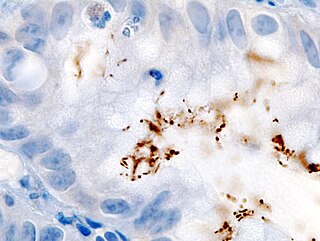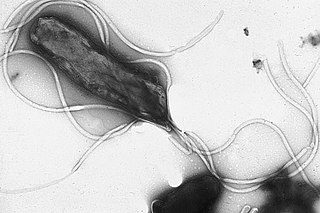
The cheetah is a large cat native to Africa and central Iran. It is the fastest land animal, estimated to be capable of running at 80 to 128 km/h with the fastest reliably recorded speeds being 93 and 98 km/h, and as such has several adaptations for speed, including a light build, long thin legs and a long tail. It typically reaches 67–94 cm (26–37 in) at the shoulder, and the head-and-body length is between 1.1 and 1.5 m. Adults weigh between 21 and 72 kg. Its head is small and rounded, and has a short snout and black tear-like facial streaks. The coat is typically tawny to creamy white or pale buff and is mostly covered with evenly spaced, solid black spots. Four subspecies are recognised.

Helicobacter pylori, previously known as Campylobacter pylori, is a gram-negative, microaerophilic, spiral (helical) bacterium usually found in the stomach. Its helical shape is thought to have evolved in order to penetrate the mucoid lining of the stomach and thereby establish infection. The bacterium was first identified in 1982 by the Australian doctors Barry Marshall and Robin Warren. H. pylori has been associated with cancer of the mucosa-associated lymphoid tissue in the stomach, esophagus, colon, rectum, or tissues around the eye, and of lymphoid tissue in the stomach.

Helicobacter is a genus of Gram-negative bacteria possessing a characteristic helical shape. They were initially considered to be members of the genus Campylobacter, but in 1989, Goodwin et al. published sufficient reasons to justify the new genus name Helicobacter. The genus Helicobacter contains about 35 species.

Achlorhydria and hypochlorhydria refer to states where the production of hydrochloric acid in gastric secretions of the stomach and other digestive organs is absent or low, respectively. It is associated with various other medical problems.
Thermus thermophilus is a Gram-negative bacterium used in a range of biotechnological applications, including as a model organism for genetic manipulation, structural genomics, and systems biology. The bacterium is extremely thermophilic, with an optimal growth temperature of about 65 °C (149 °F). Thermus thermophilus was originally isolated from a thermal vent within a hot spring in Izu, Japan by Tairo Oshima and Kazutomo Imahori. The organism has also been found to be important in the degradation of organic materials in the thermogenic phase of composting. T. thermophilus is classified into several strains, of which HB8 and HB27 are the most commonly used in laboratory environments. Genome analyses of these strains were independently completed in 2004.

This is a timeline of the events relating to the discovery that peptic ulcer disease and some cancers are caused by H. pylori. In 2005, Barry Marshall and Robin Warren were awarded the Nobel Prize in Physiology or Medicine for their discovery that peptic ulcer disease (PUD) was primarily caused by Helicobacter pylori, a bacterium with affinity for acidic environments, such as the stomach. As a result, PUD that is associated with H. pylori is currently treated with antibiotics used to eradicate the infection. For decades prior to their discovery, it was widely believed that PUD was caused by excess acid in the stomach. During this time, acid control was the primary method of treatment for PUD, to only partial success. Among other effects, it is now known that acid suppression alters the stomach milieu to make it less amenable to H. pylori infection.

The Northwest African cheetah, also known as the Saharan cheetah, is a cheetah subspecies native to the Sahara and the Sahel. It is listed as Critically Endangered on the IUCN Red List. In 2008, the population was suspected to number less than 250 mature individuals.
Lactobacillus gasseri is a species in the genus Lactobacillus identified in 1980 by François Gasser and his associates. It is part of the vaginal flora. Its genome has been sequenced. L. gasseri is a normal inhabitant of the lower reproductive tract in healthy women. It also produces Lactocillin.

Helicobacter bilis is a bacterium in the Helicobacteraceae family, Campylobacterales order. It is a fusiform bacterium with three to 14 multiple bipolar sheathed flagella and periplasmic fibers wrapped around the cell. It is resistant to cephalothin and nalidixic acid, but sensitive to metronidazole. Like Helicobacter hepaticus, it colonizes the bile, liver, and intestine of mice, and is associated with multifocal chronic hepatitis and hepatocellular tumors.
Helicobacter muridarum is a bacterium in the Helicobacteraceae family, Campylobacterales order. It is microaerophilic and helical and was first isolated from the intestinal mucosa of rodents, hence its name. It is characterised by the presence of 9 to 11 periplasmic fibers which appear as concentric helical ridges on the surface of each cell. The cells are motile and have bipolar tufts of 10 to 14 sheathed flagella. These bacteria are nutritionally fastidious and physiologically similar to other Helicobacter species and Wolinella succinogenes, but can be differentiated from these organisms by their unique cellular ultrastructure. ST1T is its type strain.
Thauera aromatica is a species of bacteria. Its type strain is K 172T.
Helicobacter felis is a bacterial species in the Helicobacteraceae family, Campylobacterales order, Helicobacter genus. This bacterium is Gram-negative, microaerophilic, urease-positive, and spiral-shaped. Its type strain is CS1T. It can be pathogenic.
Borrelia valaisiana is a spirochaete bacterium; strain VS116 is the type strain. It is a potential pathogen.
Mycoplasma penetrans is a species of Gram-positive bacteria. It is pathogenic, though many infected show no symptoms. It is a sexually transmitted disease, though an infant may be infected during birth.
Helicobacter canadensis is a bacterium in the Helicobacteraceae family, Campylobacterales order, first isolated from humans with diarrhea. Its genome has been sequenced.
Helicobacter pametensis is a bacterium in the Helicobacteraceae family, Campylobacterales order. It was first isolated from bird and swine faeces. Its cells are motile and possess one subterminal sheathed flagellum at each end.
Helicobacter anseris is a bacterium in the Helicobacteraceae family, Campylobacterales order. It is Gram-negative, microaerophilic, spiral to curve-shaped, being first isolated from the faeces of geese.
Helicobacter brantae is a bacterium in the Helicobacteraceae family, Campylobacterales order. It is Gram-negative, microaerophilic, spiral to curve-shaped, being first isolated from the faeces of geese.
Lactobacillus kefiranofaciens is a species of slime-forming, homofermentative, rod-shaped lactic acid bacteria first isolated from kefir grains, hence its name. Its type strain is WT-2B. Its genome has been sequenced.

Mark Achtman FRS is Professor of Bacterial Population Genetics at Warwick Medical School, part of the University of Warwick in the UK.






